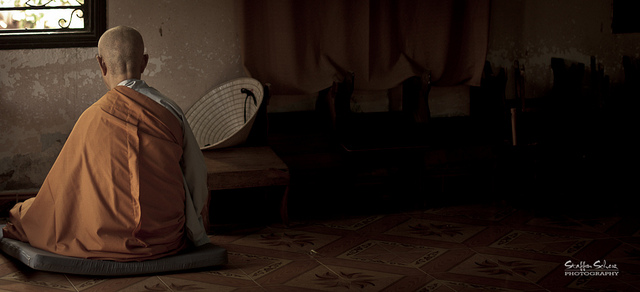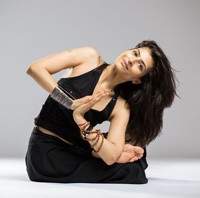
“Quiet friend who has come so far,
feel how your breathing makes more space around you.
Let this darkness be a bell tower
and you the bell.
As you ring,
what batters you becomes your strength.
Move back and forth into the change.
What is it like, such intensity of pain?
If the drink is bitter, turn yourself to wine.
In this uncontainable night,
be the mystery at the crossroads of your senses,
the meaning discovered there.
And if the world has ceased to hear you,
say to the silent Earth: I flow.
To the rushing water, speak: I am.”
~ Rainer Maria Rilke
Meditation is not a new age phenomenon.
It is something so inherently coded in the human organism that to think of it as an stranger who have to consciously make space and time for, is misleading.
We are far more intimate with that stranger than we might remember.
Meditation is our natural state—at one with the present moment.
Our hectic lives have made the practice of meditation seem like an enigma—something to be learnt by great masters. In truth, meditation is quite simply the dropping in of one’s senses to a place of restful focus within. It is like the quiet inward turning of the ocean-wave back to the center of the ocean, like a babies’ gaze into nothingness with presence to the fluttering of her own breath.
It’s that primordial return to self—a natural state that we once knew of and have, but have lost touch with.
Rainer Maria Rilke threads together the essence of presence through his words.
Though he may speak of darkness, his gentle nudge to simply flow, to let the breathing make more space, to become the mystery at the crossroads so that we may find the meaning there, is perhaps a poet’s way of inviting a moment to live to it’s fullest, in us.
And that is perhaps the greatest teaching of meditation: to be where we are, absorbing all that we can sense, without resistance.
But modern life, especially in a big city, offers incessant sensory distractions. Being in nature allows us to draw our senses inward, where we can more easily navigate and map the sensations entering the self without offering as much resistance.
Nature has a way of disarming our resistance. Those experiences of gazing deep into a fire or listening to the sound of the ocean or a dense forest effortlessly take us into a quiet place within. We find ourselves drawn toward a window of quietude between thoughts.
This place feels uncannily like home—a return to a forgotten self. And once we cultivate the practice, this sense of deep interconnectedness to the undercurrent of presence does not need to be dependent on being in nature.
We can connect with it wherever we may find ourselves, .
This leads me to share a sutra from the Bhairava Tantra, as translated by Lorin Roche (Verses 10-12):
“Elaborate rituals and garish images
May be useful in meditation when you mind is whirling with thoughts
Of sex, money, and power, wandering like an elephant in heat
Go ahead and use these tools, yet know,
Beating drums and blaring trumpets
Cannot summon the One who is already present.
I am not a collection of incantations
Known only to experts.
I am not a ladder to be climbed,
A sequence for piercing energy centers in your body.
I am not to be found at the end of a long road.
I am right here.”
This sutra poetically articulates that all we will ever need to turn inward is already present inside us.
The candles, the elaborate altars invoking divinity may help the distracted mind, but turning to that luminous presence within is something accessible to each one of us.
Meditation guidelines and “gurus” have mystified meditation, made it seem as though this state of oneness it can only be achieved through some personal ordeal or effort and finding the right space.
This view limits our access to something that is actually available to us at all times. However, like pretty much everything else, meditation requires practice.
A returning to that space of quietude within is a habit we learn to remind ourselves of. And this can simply begin with taking a moment in the span of a day where we cultivate the habit of tuning in and focusing on the rise and fall of breath in the body.
A simple observation of breath as it fills the body, and the exhale that follows is a small practice of bringing awareness back to the body and its connection to breath.
The connection is here, in these small moments of turning inward and focusing on the quietness, simply becoming aware of all the sensations as they enter our awareness while relinquising the responsibility of judging, examining or labeling them. Here, where we simply open our cells to receive awareness and welcome all the sensations that arrive.
This practice brings me to Rumi’s famous poem, The Guest House:
“This being human is a guest house
Every morning a new arrival.
A joy, a depression, a meanness,
some momentary awareness comes
as an unexpected visitor.
Welcome and entertain them all!
Even if they are a crowd of sorrows,
who violently sweep your house
empty of its furniture,
still treat each guest honorably.
He may be clearing you out for some new delight.
The dark thought, the shame, the malice,
meet them at the door laughing,
and invite them in.
Be grateful for whoever comes,
because each has been sent
as a guide from beyond.
~Rumi
The sages and the ancients knew that whatever arrives has its place.
We must try not to tailor or manipulate it, repress it to fit some preconceived notion of what we can allow ourselves to feel and what we should avoid.
Meditation is simply a turning inward, and acknowledging, with grace, what is arising. And letting it be—letting it travel to the farthest reaches of our being, allowing ourselves to be imbued by it. Breathing with it.
In acknowledging, absorbing, accepting and even leaning in to hear its counsel, we begin the process of dissolving the hardened notions we had of ourselves, the times we were unforgiving of ourselves and the obstacles that we placed between who we think we are and our authentic inner reality.
To be present to everything without bringing forth any judgment or tailoring it in any way is to live meditatively.
To be connected to the deep undercurrent of life, to allow it to take us by the hand, as it wants to—is to experience the many delights of being human.
~
Relephant read:
Meditate for the Poetry, not for the Calm.
~
Author: Tania Kazi
Editor: Khara-Jade Warren
Image: Staffan Scherz/ Flickr
~
 Share on bsky
Share on bsky




Read 1 comment and reply